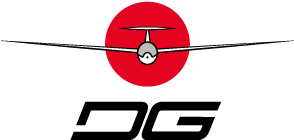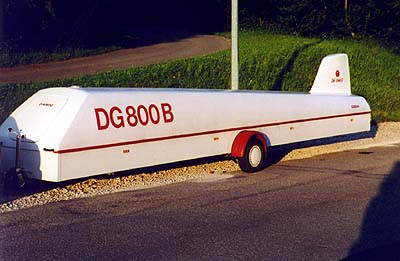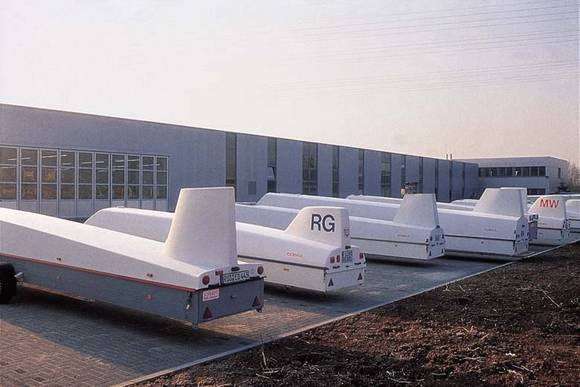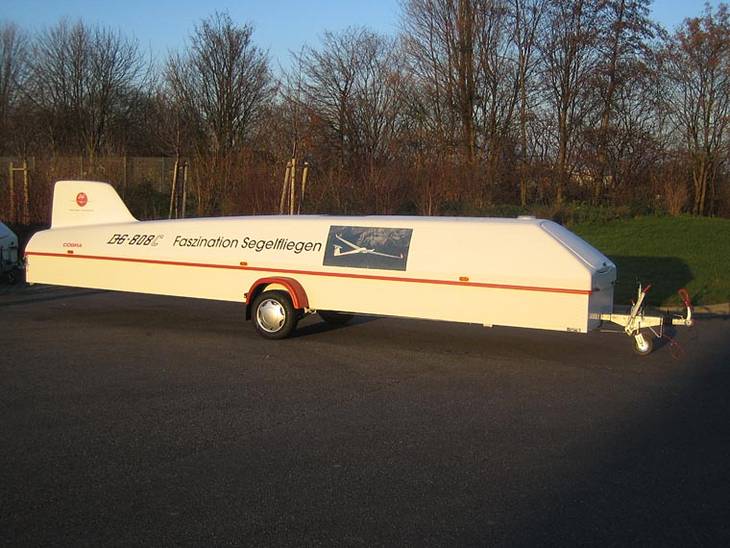A Safe Trailer for the Next Season
Just like the sailplanes so do transport trailers need attention and care, to avoid unpleasant surprises.
Hereby the suggestions of a professional as to what urgently needs to be checked.
The first suggestion is not so much about maintenance. But it should help especially the clubs to increase the readiness of their sailplane trailers considerably. For a few years now there are two electrical plug systems (7 and 13 polar) in use, and, as is usual at airfields, a suitable adapter is not always available. This can be avoided by installing a second cable and plug. If the plugs are housed in the same covered box corrosion of the contacts can be avoided and also the inefficient “salad” of cables. The necessary material can be obtained from RV suppliers, auto shops and the trailer manufacturer.
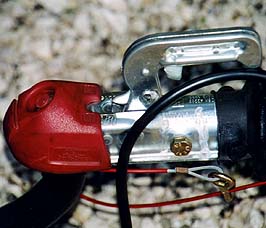
RV Shops are also a source of another important accessory that can extend the life of the connector shaft considerably: a cover for the self braking mechanism. House trailers have used them for years, and there is no reason why sailplane trailers parked in the open should not benefit from one. A cover prevents the gradual washing out of the grease, or it’s hardening from direct sunlight.
The following is an overview of the maintenance procedures, beginning at the front of the trailer, which should be carried out before winter storage.
1. Electric Plug:
Clean contacts, sandpaper, straighten pins, use contact spray. Treat plug on tow vehicle the same way.
2. Trailer Coupling:
Test workings, does the automatic lock work? If the trailer had been rearranged the coupling has to be replaced! This type of accident damages the locking mechanism beyond safe tolerances. Therefore a safe connection to the tow vehicle is no longer guaranteed.
3. Rubber Cover:
If the rubber cover is damaged the self braking mechanism can rust and lock. Solution:
Exchange or repair using bicycle repair kit.
4. Safety Chain:
Visually inspect for kinks, is the weak link o.k.? Weak links must never be strengthened.
5. Safety Brake:
Grease. Test function.
6. Hand Brake / Brakes:
The position of the hand brake is an important indicator for the wear of the brake linings. If the brake lever moves past vertical to aft the wheel brakes need adjusting. To do this, jack up the trailer and secure it, turn wheel by hand, and lever the adjustment wheel in the direction of + until the linings touch lightly, then back off until the wheel spins freely. Under no circumstances adjust the brake rods! Occasionally the brake linings should be visually inspected. Old, hardened linings should be replaced. The bowden cables should be cleaned and greased to keep them freely moving. Never drive with frozen bowden cables or with the hand brake on. Because of the resulting overheating the grease in the wheel bearings will melt and run out, and the overheating of the bearings can sever the axle and cause a loss of the wheel! Overheating of the axle grease usually results in radiating grease traces on the tire or rim.
7. Tires:
Check general condition, depth of profile, and pressure. The life expectancy of a tire because of deterioration of the rubber compounds is six years. Tires on sailplane trailers suffer from long standing. If after a long winter storage an overage tire is subjected to high speeds to get you to the airfield, a burst tire is almost inevitable. A sailplane, often valued at $ 60,000 or more should be worth the price of a couple of new tires. If new tires are mounted, the wheel lugs should be re-tightened after 50 or so miles of driving. This is also true of new trailers after delivery. Tire air pressure should be 2.6 to 2.8 Bar.
8. Electric’s:
Test all functions, exchange bulbs where necessary. If the rear fog light does not function, or is on all the time, the appropriate contact pin in the plug should be checked. Naturally, all light fixtures on the trailer should function.
9. License Plates / Papers:
Are the plates valid ? Are the papers in an accessible place?
10. Front Door Hinges / Rear Door Hinges:
Grease !
11. Top Hinges:
Please check. Brace top open securely. After taking off the guide, lift carpet at the telescopic pipe and undo safety screw and wing nut. If scratches are visible or the screw is deformed, replace both screw and wing nut. A frozen arm linkage can break the screw. New screws and nuts can be obtained from the manufacturer. While doing this check also remove the telescopic cover, clean interior. Grease and remount. The gas shock absorber should have a bit of play in the telescopic pipe. Please do not use shims.
12. Accessories:
Check all the interior fittings, clean and grease where appropriate. Check the cushioning material. If it is too depressed, or worn through, it must be repaired.
Now, if the exterior of the trailer is cleaned and polished with a good auto or boat polish to a gleaming shine, then the safety and protection of the trailer is assured.
– Alfred Spindelberger –
Alfred Spindelberger is the owner of the Cobra trailer manufacturer, and therefore well informed. This article was published in “Aerokurier” and is reproduced with the kind consent of the publishers.
Mr. Spindelberger is owner of a private DG-800B!
translated by Albin Schreiter, Canada
Safety hitch with a stabilizer
It’s been quite a while now, since trailer manufacturers started to offer trailers with special hitches, stabilizing the trailers. For example you’re allowed to drive at speeds up to 130 km/h in France.
But try that with a two seater – or better not. It’ll result in an accident. And the same goes for a single seater. Those trailers will start so swerve around in moderate wind, giving the driver a hard time and lowering his “pleasure”.
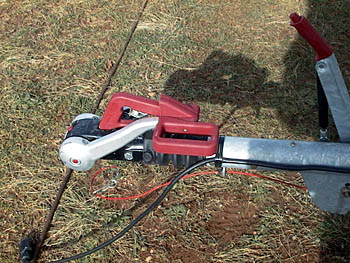
The safety hitch with stabilizers uses two “brakes” in the hitch, which will reduce the movements of the trailer. It’s therefore impossible that the trailer will start to bump up and down. There is no need to change anything in the towing vehicle.
There may also be other systems that I don’t know about.
Nevertheless we have come to the conclusion that all trailers used by DG will be refitted with those safety hitches.
It’s fairly simple by the way. The trailer manufacturer supplies the stabilizer hitch. The only thing you need to do is to remove the bolt. You can than connect the safety hitch all by yourself.
The new hitch has done a fabulous job on the first long trip to Vinon, France. It’s a plus in safety and it should be made law to add a safety hitch. That would reduce the number of accidents by quite a margin.
The costs of a safety hitch are in no means worth a comparison to the value of the transported plane.
A safety hitch sells for around $ 200. I’ll also cause a legislature in my gliding club and change the hitches there.
The only thing to keep in mind is: Do not add any oil or grease to the linings. The system will not work with grease. Carefully clean the hitch before every use. Also clean the everything that will be connected to the hitch before use. (towing bar,….)
A nice side effect is a clean pair of pants.
The handling of a refitted trailer will happily surprise you.
translated by Thiemo Gorath
A Comment for US-customers:
Mr. Weber,
this is an excellent device and I installed it on my trailer several years ago with good results. However, for the USA you should add a couple of special notes. The special hitch is only available in 50mm and not 2 inch, so for the USA it is necessary to find a 50mm ball and this is quite difficult. (I purchased mine while in Australia on a soaring vacation.)
The other concern is that the ball design used for the USA can possibly rotate when clamped by the special hitch – so the ball must be specially secured.
Regards and Happy Holidays,
Jim Herd
Is that possible???????
Public Relation for our Sport
Normally our trailers are pure white, although they have good surfaces for advertisings. What do you think about making public relation by using our trailers?
